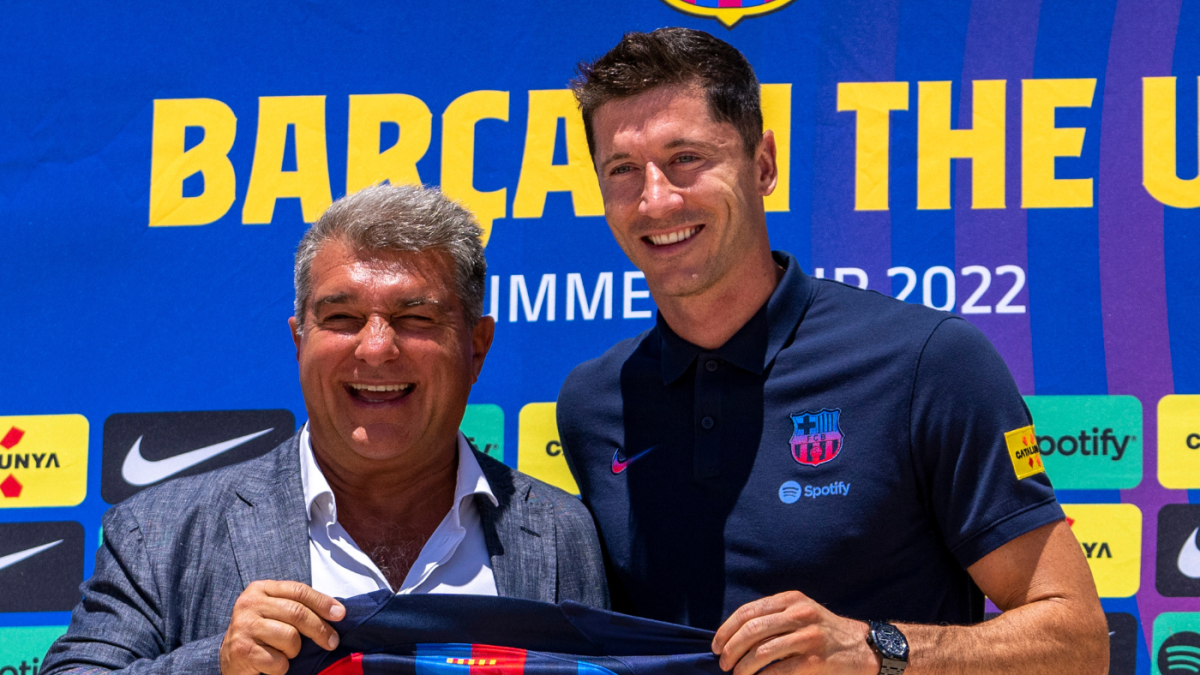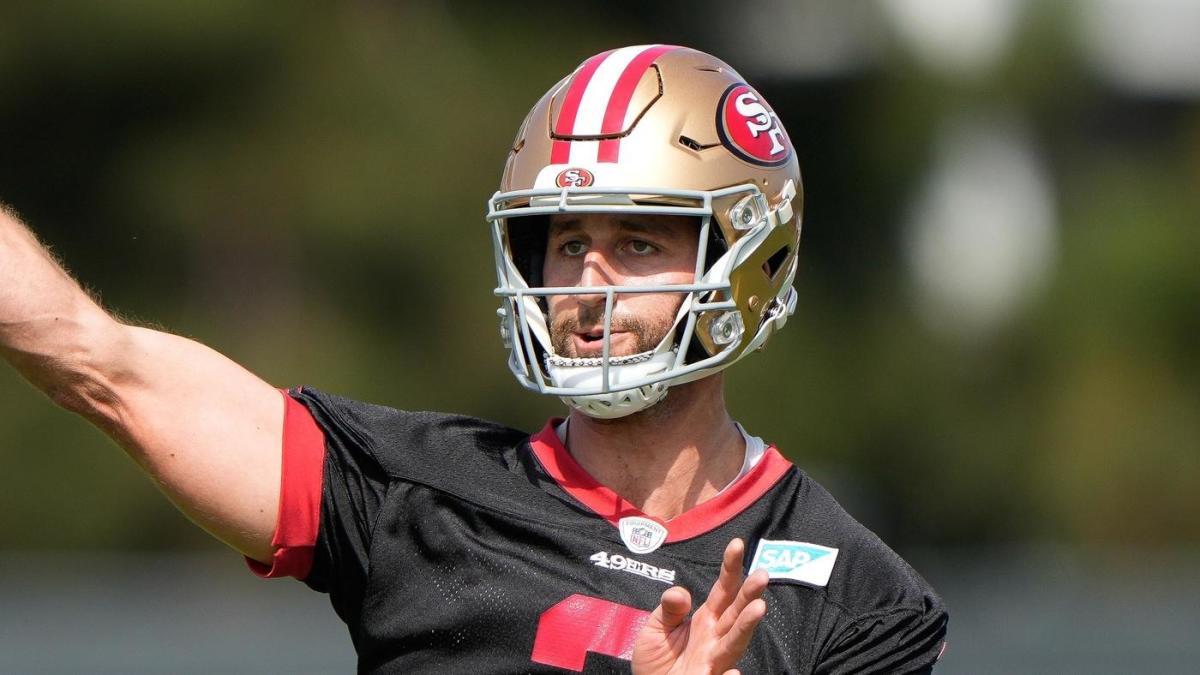Barcelona transfers explained: Robert Lewandowski, Raphinha aren’t worth the cost for cash strapped Blaugrana
Written by ABC Audio ALL RIGHTS RESERVED on July 22, 2022

It is perhaps appropriate that Barcelona’s pre-season tour of the USA should take them to Las Vegas this weekend. Pulling at economic levers in the hopes of a transformational injection of cash? Joan Laporta’s approach for rebalancing the books at the Camp Nou is similar enough to the denizens of the casino floor to justify this tortured analogy.
How are Barcelona raising money?
At least Laporta’s gambles come with a guaranteed pay off. Friday brought the latest sale off Barcelona’s off-field assets to bring the cash injection the club has so desperately needed. Having sold 10 percent of its domestic television rights over the next 25 years to Sixth Street for €267 million (€207.5m of it upfront), the club announced today that they had parted with a further 15 percent to the US investment fund.
In 2019-20 the club were paid €165m for their La Liga broadcast rights; if that figure were to stay broadly static over the lifespan of Sixth Street’s investment then Barcelona would pay back in excess of €400m. In investing in what their CEO Alan Waxman described as “one of the world’s premier sporting organizations”, Sixth Street will be hoping to earn more than that as broadcast markets expand. For instance the new Spanish television deal with Telefonica and DAZN that comes into effect this season is a slight increase on the previous agreement, earning €980m a year, €80m more than previously.
Meanwhile Barcelona are also working to sell 49.9 percent of their merchandising operation as part of a process that they help will bring around €700m into the club coffers. Make no mistake, that money is needed. Only a year ago the recently elected Laporta was laying out the financial cataclysm that had befallen the Catalan giants. Debt was at €1.35 billion. For every €1 of revenue the club brought in €1.03 was being spent on player wages.
COVID-19 had blown an almighty hole in the Barcelona vessel, though it had hardly been kept in ship shape. In the good times the club had been spending a huge chunk of their vast revenues on transfer fees and wages for players whose impact was often questionable. Then came the crisis. The greatest player in the club’s history, Lionel Messi, was compelled to walk out of the door because there was no way to keep him under La Liga’s financial rules, which could still cause all sorts of headaches for the club this summer.
In short, Barcelona need the money. The approach by which they have attained it is open to debate; the club is effectively taking a machete to future income to get at their cash now. That is hardly an approach without precedence in the business world and when the financial circumstances are as dire as they have been at the Camp Nou — where there is no billionaire owner to bail them out but instead 140,000 club members or socis — some form of refinancing might be justifiable if the money was being invested in the right places.
Are Barcelona making smart buys?
That is the rather more significant debate around Barcelona right now. The family silver is being paid off but not to fix the leaking roof. It is, at least in part, to acquire new trinkets for Xavi. First came Raphinha for up to €67m, then Robert Lewandowski at €50m. Franck Kessie and Andreas Christensen had already been signed on free transfers (a term which handily ignores the rather large wages that can accompany such a “free” move). The spending may not stop there with Bernardo Silva a target and interest in Chelsea captain Cesar Azpilicueta.
Lewandowski’s former manager Julian Nagelsmann is baffled. He is not alone in that regard, across the football world there is confusion as to why this is the approach that Barcelona have taken. “It’s the only club in the world that can buy players without money,” Nagelsmann said. “It’s kind of weird and crazy.” Of course the counterpoint would be that they do have the funds, the issue is how they are deploying them.
Robert Lewandowski has been one of the best strikers in the world for a decade but he is 33. Barcelona already have one of those having picked up Pierre-Emerick Aubameyang when he was pushed out of the Arsenal exit door in January. Aubameyang lit up La Liga with 11 goals in 17 games on his arrival; perhaps the calculus is merely that if one veteran striker who lit up the Bundesliga can do that, imagine what two can do.
It is no less challenging to square the decision to sign Raphinha when the club already had Ansu Fati, Ferran Torres, Memphis Depay and Ousmane Dembele on the books, the latter on a reduced contract after a very public war of words between the club and the France international’s representatives over what is a fair price.
That looks like a minor skirmish compared to the ructions caused by Barcelona’s attempts to move on Frenkie De Jong, one of the few players on their books who could command a significant fee. That has been agreed with Manchester United at an initial €75m but pushing the player out against his will appears to be an almighty challenge, particularly when they reportedly owe him €17m in deferred salary that he had agreed to help ease the COVID-19-induced pressure on club finances. He might point out that it would be unfair to ask him to waive money if it is only going to be used to fund further transfer business.
The emergence of Pedri and Gavi certainly makes De Jong less of a lodestar for Barcelona than he appeared to be when he arrived from Ajax three years ago but he remains an extremely talented 25 year old waiting to be molded into the Sergio Busquets successor Xavi will need sooner or later. As for those two homegrown midfielders, they paint the way to a youth-oriented rebuild that might be easier to tolerate at the Camp Nou than any other big club.
No one has explained the premium Barcelona place on youth development quite as succinctly as Laporta himself. After Cristiano Ronaldo moved to La Liga in 2009 he offered a vision of the difference between his club and their great rivals Real Madrid in all of 11 words. “We make Ballon d’Or winners. Others have to buy them.”
The only reason that he cannot be fully hoisted by that particular petard is that Messi beat Lewandowski to the Ballon d’Or. Still Barcelona have just bought the FIFA Best Men’s Player. Of course Laporta might also point to the transformative impact of superstar signings from Barcelona’s history. He will remember well Johan Cruyff’s impact on the club and indeed the city when he first arrived on a world record fee in 1973, guiding them to a first La Liga title in 14 years a year later. He might even point to the propulsive impact of Ronaldinho when he began his first tenure as club president in 2003, the start of a glorious decade-plus for the Blaugrana.
He even spoke in those terms at Lewandowski’s unveiling, framing the new signing as one to bring repute back to the institution. “We are recovering the specific weight that Barcelona had and positioning Barcelona in the world again. We will continue to build a competitive team as much as our means will allow.” Of course when Cruyff arrived at Barcelona he was 26 years old and the five years he spent in Catalan country represented the prime of his career. Ronaldinho was younger still at 23, giving Barcelona a star rising to its ascendency.
Is it particularly prestigious to sign up for paying Lewandowski who while still performing at an exceptionally high level is clearly on the other side of that arc. His performance will surely decline, perhaps precipitously, at some stage over the next four years? And even without the Polish striker, Barcelona still had Raphinha to serve as a statement signing, if such demonstration of intent was deemed necessary, proving the enduring mythology of Barcelona is enough to lure players away from the Premier League’s financial muscle. Though, the tortuous nature of getting him from Leeds offers a further statement of how difficult doing business with Barcelona can be.
Just how good are Barcelona now?
And where will the spending take Xavi’s side? One might justify the January additions of Aubameyang, Ferran Torres, Adama Traore (who had been encouraged to take a pay cut on his loan from Wolves in expectation of a permanent deal that never came) as necessary to allow the team to scrabble their way into the Champions League. One might also point out that even before those January signings they had the best expected goal difference in La Liga and could have expected to make the charge up the table they eventually did.
Lewandowski aside, it could be argued that the new signings have merely added depth to Xavi’s options and are unlikely to be locks for the biggest games. This is not a team that looks to be a match for the big beasts at the business end of European competition; it might be for Real Madrid but then the 4-0 win at the Santiago Bernabeu in March suggested that the previous iteration could have been too. Though this drives home the point that Real Madrid similarly did not look a match for those big beasts until, well, they were.
Ultimately Barcelona may have done nothing more than gambled the long term financial footing of the club to take themselves from a possible top two finish in La Liga and quarter final berth in the Champions League to a possible top two finish in La Liga and quarter final berth in the Champions League. There’s always a chance a team at that level could win it all. It happened for Madrid last season. But even the most bold men and women in Vegas might suggest to Laporta that that gamble isn’t one worth taking.
The post Barcelona transfers explained: Robert Lewandowski, Raphinha aren’t worth the cost for cash strapped Blaugrana first appeared on CBS Sports.






